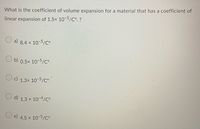
College Physics
11th Edition
ISBN: 9781305952300
Author: Raymond A. Serway, Chris Vuille
Publisher: Cengage Learning
expand_more
expand_more
format_list_bulleted
Concept explainers
Question

Transcribed Image Text:What is the coefficient of volume expansion for a material that has a coefficient of
linear expansion of 1.5x 10-5/C°. ?
a) 8.4 x 10-5/C°
b 0.5x 10-5/c°
c)
1.3x 10-5/Co
O d) 1.3 x 10-4/C°
e) 4.5 x 10-5/C°
Expert Solution
This question has been solved!
Explore an expertly crafted, step-by-step solution for a thorough understanding of key concepts.
Step by stepSolved in 2 steps

Knowledge Booster
Learn more about
Need a deep-dive on the concept behind this application? Look no further. Learn more about this topic, physics and related others by exploring similar questions and additional content below.Similar questions
- 11:07arrow_forwardThe coefficient of linear expansion of the steel is 1.10 x10-5C°. If at a temperature of -15°C the length of the bridge (made with steel ) is 50.8 m then, what is a change in length if the temperature rises to 30°C? 1.784 mm 2.98 mm 2.51 cm 28.7 µmarrow_forwardA mountain hiker tightens the cap on a half-full plastic water bottle at a high altitude. The volume of air in the sealed bottle is 5 x 10-4 m³, the pressure is 64 kPa and the temperature is -8 °C. The hiker descends to a lower altitude where the pressure is 94.2 kPa and the temperature is 11 °C. What is the final volume of the sealed air inside the bottle? (this is what causes the plastic bottle to deform if you've ever experience this situation)arrow_forward
- 3 E 2. A concrete highway is built of slabs 19.0 m long (at 23 °C). How wide should the expansion cracks be (at 23 °C) between the slabs to prevent buckling if the annual extreme temperatures are -37 °C and 52 °C?(the coefficient of linear expansion of concrete is 1.20 x 10-5 °C-¹) meters D # L 835 ه R % F الله ساك 5 V B T G 6 MacBook Air --- B & 7 I 8 N FB 0 ا K M 2 هوarrow_forwardA quantity of mercury occupies 400.0 cm³ at 0°C. What volume will it occupy when heated to 50°C? Mercury has a volume expansion coefficient of 180 x 10-6 K-1. 450 cm3 401.8 cm3 O403.6 cm³ O409.7 cm3arrow_forward5. Consider two unknown substances, substance A and substance B, which are placed in contact inside an open container. The container is in a VERY large room and the room is a very warm 40°C. Below are T Vs E Added plots for substance A (left) and substance B (right): T(°C) 80 60 40 20 0 -20 i Substance A 200 400 600 800 1000 1200 1400 E Added (J) T(°C) 80 60 40 20 0 -20 Substance B 200 400 600 800 1000 1200 1400 E Added (J) The initial state of substance A is labeled. In the final state, substance A and substance B are both in thermal equilibrium with the room. If substance A and substance B absorbed a combined total of 1700J in the form of heat what was the initial temperature and phase of substance B?arrow_forward
- During an all-night cram session, a student heats up a 0.807 liter (0.807 x 10- 3 m3) glass (Pyrex) beaker of cold coffee. Initially, the temperature is 15.5 °C, and the beaker is filled to the brim. A short time later when the student returns, the temperature has risen to 98.0 °C. The coefficient of volume expansion of coffee is the same as that of water. How much coffee (in cubic meters) has spilled out of the beaker?arrow_forward2kg of ice at 0 degree celsius are placed in a closed glass beaker( k = 0.80W/m-c). The closed beaker is then placed in a 30 degree celsius room The surface area of the beaker is 5x10-3 m² and its walls are 0.005m thick. How much heat is required to melt the ice? How long does it take the ice to melt?arrow_forwardA hot air balloon uses the principle of buoyancy to create lift. By making the air inside the balloon less dense then the surrounding air, the balloon is able to lift objects many times its own weight. A large hot air balloon has a maximum balloon volume of 2090 m3. a. If the air temperature in the balloon is 54 °C, how much additional mass, in kilograms, can the balloon lift? Assume the molar mass of air is 28.97 g/mol, the air density is 1.20 kg/m3, and the air pressure is 1 atm.arrow_forward
arrow_back_ios
arrow_forward_ios
Recommended textbooks for you
 College PhysicsPhysicsISBN:9781305952300Author:Raymond A. Serway, Chris VuillePublisher:Cengage Learning
College PhysicsPhysicsISBN:9781305952300Author:Raymond A. Serway, Chris VuillePublisher:Cengage Learning University Physics (14th Edition)PhysicsISBN:9780133969290Author:Hugh D. Young, Roger A. FreedmanPublisher:PEARSON
University Physics (14th Edition)PhysicsISBN:9780133969290Author:Hugh D. Young, Roger A. FreedmanPublisher:PEARSON Introduction To Quantum MechanicsPhysicsISBN:9781107189638Author:Griffiths, David J., Schroeter, Darrell F.Publisher:Cambridge University Press
Introduction To Quantum MechanicsPhysicsISBN:9781107189638Author:Griffiths, David J., Schroeter, Darrell F.Publisher:Cambridge University Press Physics for Scientists and EngineersPhysicsISBN:9781337553278Author:Raymond A. Serway, John W. JewettPublisher:Cengage Learning
Physics for Scientists and EngineersPhysicsISBN:9781337553278Author:Raymond A. Serway, John W. JewettPublisher:Cengage Learning Lecture- Tutorials for Introductory AstronomyPhysicsISBN:9780321820464Author:Edward E. Prather, Tim P. Slater, Jeff P. Adams, Gina BrissendenPublisher:Addison-Wesley
Lecture- Tutorials for Introductory AstronomyPhysicsISBN:9780321820464Author:Edward E. Prather, Tim P. Slater, Jeff P. Adams, Gina BrissendenPublisher:Addison-Wesley College Physics: A Strategic Approach (4th Editio...PhysicsISBN:9780134609034Author:Randall D. Knight (Professor Emeritus), Brian Jones, Stuart FieldPublisher:PEARSON
College Physics: A Strategic Approach (4th Editio...PhysicsISBN:9780134609034Author:Randall D. Knight (Professor Emeritus), Brian Jones, Stuart FieldPublisher:PEARSON

College Physics
Physics
ISBN:9781305952300
Author:Raymond A. Serway, Chris Vuille
Publisher:Cengage Learning

University Physics (14th Edition)
Physics
ISBN:9780133969290
Author:Hugh D. Young, Roger A. Freedman
Publisher:PEARSON

Introduction To Quantum Mechanics
Physics
ISBN:9781107189638
Author:Griffiths, David J., Schroeter, Darrell F.
Publisher:Cambridge University Press

Physics for Scientists and Engineers
Physics
ISBN:9781337553278
Author:Raymond A. Serway, John W. Jewett
Publisher:Cengage Learning

Lecture- Tutorials for Introductory Astronomy
Physics
ISBN:9780321820464
Author:Edward E. Prather, Tim P. Slater, Jeff P. Adams, Gina Brissenden
Publisher:Addison-Wesley

College Physics: A Strategic Approach (4th Editio...
Physics
ISBN:9780134609034
Author:Randall D. Knight (Professor Emeritus), Brian Jones, Stuart Field
Publisher:PEARSON